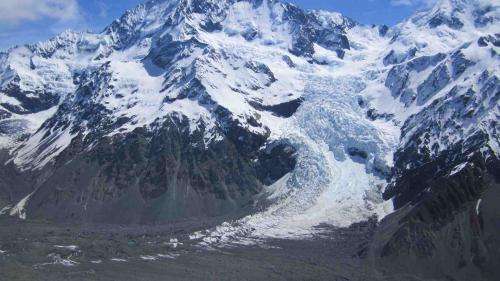Southern Alps glaciers reducing rapidly

Historic records show Franz Josef Glacier retreated three kilometres in the last century and mathematical modeling indicates it is likely to retreat even more this century.
Other glaciers in the region, including Fox Glacier, are declining at similar rates as a result of climatic change says Dr Brian Anderson, a senior research fellow at the Antarctic Research Centre, who is supported by a Marsden Fast Start research grant.
Dr Anderson says mathematical modelling helps him, and other researchers in the team, understand how glaciers have evolved since the last ice age. It also helps them analyse what is occurring now and predict how many glaciers in the Southern Alps will fare in the future.
"It's important to see the long term picture to really understand what's going on. That's because many of our glaciers—Fox and Franz Josef particularly—change so quickly and, apparently, so erratically.
"In the 12 years we've been carrying out this study, we've seen them rapidly retreat and then rapidly advance. It's not until we look back over the past century that we see an overall pattern of retreat emerging," says Dr Anderson.
"Looking ahead, we are likely to see warmer and wetter weather, which means Franz Josef and Fox glaciers will retreat a lot—our best estimate is that they will be seven or eight kilometres shorter than present by 2100."
The research findings are being collated and published as part of the Antarctic Research Centre's glacier monitoring project which also involves Dr Ruzica Dadic, Dr Huw Horgan and Associate Professor Andrew Mackintosh.
Together, the researchers are observing and measuring three glaciers—the well-known Franz Josef and Tasman glaciers and the lesser-known Brewster Glacier.
Other collaborators on the Brewster Glacier project are Dr Nicolas Cullen at the University of Otago and Dr Andrew Lorrey at NIWA.
The data gathered is contributing to the University of Zurich's World Glacier Monitoring Service.
Dr Anderson says: "Already we are seeing issues at Franz Josef Glacier, where walking access has not been possible for more than a year, and tourists are now being flown onto the ice. These are the kinds of things being predicted to happen around the world as glaciers decline and temperatures continue to warm," he says.
Dr Anderson has travelled to the glaciers of the Southern Alps on a monthly basis for more than a decade. His fieldwork typically involves drilling four-metre long poles into glacier ice and timing how long it takes for the ice around each pole to melt away. Global positioning technology is used to track glacier movement.
Each year, Dr Anderson and his team trek on the upper reaches of Franz Josef Glacier to look down crevasses and gauge how much snow is left after the summer melt. At Brewster Glacier, a small alpine glacier near Haast in South Westland, they use long sticks, called probes, and ground-penetrating radar to measure the depth of the snow.
Earlier this year, Dr Anderson says a 70-metre chunk of ice broke off the terminal face of Tasman glacier, releasing an estimated seven million cubic metres of ice into Tasman Lake.
"Tasman is undergoing rapid decline right now, with large chunks breaking off and falling into Tasman Lake. We are using time-lapse photography to capture these 'calving' events as they happen and gather valuable information on ice loss and glacier behaviour at the same time."
Provided by Victoria University




















